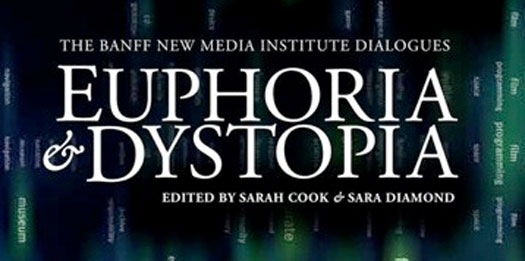

The digital age saw its euphoric rise in the 1990s with the popularization of the Internet and the emergence of the World Wide Web, only to collapse in economic crisis at the end of the century. It was during these turbulent years that Dr. Sara Diamond, then Director of Research for the Banff Centre, founded the Banff New Media Institute (BNMI) and led it to become an internationally renowned arts production and research institute. As Director from 1995-2005, Diamond, now President of OCAD University and a GRAND Board Member, initiated cutting-edge research summits and workshops that explored the near future of digital media. These meetings were the setting for fundamental discussions concerning new methods of collaboration and research that helped to shape art, design, science and technology research in Canada. Following fifteen years of award-winning co-productions and dialogue on the aesthetics and culture of new media, the BNMI ceased operations in 2010.
In January 2013, in Toronto, the Euphoria and Dystopia Symposium, co-sponsored by GRAND and OCAD University, offered an occasion to reflect on the important legacy of the BNMI, revisiting the digital concerns of the 1990s and early 21st century in view of recent research, industrial, social and cultural trends. The event was inspired by the launch (held at the symposium) of Euphoria & Dystopia: the Banff New Media Institute Dialogues, a new book edited by Diamond and Dr. Sarah Cook (University of Sunderland, UK), which documents the BNMI dialogues during the period of 1995-2005. The book gives international perspective to the major developments in new media practice and research with consideration of earlier roots and later history.
BNMI participants, many of whom are now in the GRAND network, along with current digital media researchers, designers, artists, scientists and students attended the one-day symposium focused on themes drawn from Euphoria & Dystopia. Panel discussions and workshops examined issues of online social and individual identity gender, curatorial practice and digital art’s exhibition and historicization, new media economies, models of production and collaboration and changes in how we understand humanity, among other contemporary topics.
The symposium included a student-focused workshop the day before with keynote presentations by Sarah Cook, Sara Diamond and Susan Kennard. Catherine Richards, past BNMI participant, University of Ottawa professor and visual artist, also announced a new grant initiative sponsored by GRAND and the Canada Council for the Arts. The pilot program supports new projects that pair scientists and artists in media arts collaboration.
Although the Institute is no longer, the symposium helped affirm that the contributions made by artists, faculty, and staff collaborating within the BNMI continue. Speaking at Huron University College at Western University last fall, Diamond expressed how she saw the BNMI legacy:
The spirit of the BNMI is
alive and well. It lives in science’s defence of experimentation, of speaking
uncomfortable truths, of providing evidence and demanding action on the basis
of evidence. Art and design act as a different kind of evidence – of
imagination, integrated reasoning, of affect and experience. And it lives on in
the many initiatives, such as the GRAND Network of Centres of Excellence and in
academic programs such OCAD U’s Digital Futures Initiative and many others.
Banff New Media Institute (BNMI)
The Banff New Media Institute (1995-2010), located in the awe-inspiring Rocky Mountains at the world renowned Banff Centre, was a dynamic international centre that addressed dramatically changing times — the heady rise of the digital age, its tumultuous descent, and its reformulation. BNMI hosted leading artists, designers, computer scientists and engineers, mathematicians, physicists, biologists, chemists, humanists, social scientists, and medical researchers. Its cutting edge summits (think tanks) foretold that future. These occurred at The Banff Centre, side by side with international artists’ residencies, co-productions, transdisciplinary research, new media exhibitions and the incubation of commercial products and companies. The BNMI predicted and shaped trends in digital media.
-30-